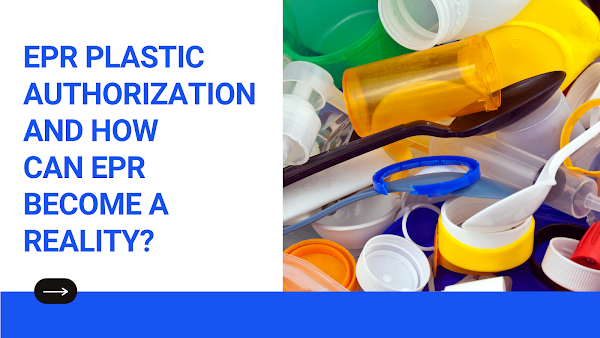EPR Plastic Authorization and How Can EPR Become A Reality?

Extended Producer Responsibility (EPR) is a word that refers to the practice of assigning producers’ responsibility for the end-of-life management of products and materials. There are two basic objectives in developing such a system:
- Municipalities will be relieved their burden by producers sharing physical and/or financial responsibilities for garbage management.
- Providing an opportunity for manufacturers to produce goods that are resource-efficient and have a low environmental effect.
EPR systems
EPR systems have helped to design effective separate collection plans for specific waste streams, such as plastic packaging. Industry is now covering at least a portion of the investment and operational costs for waste management of used packaging. This has the potential to be a great benefit for developing countries because the incapacity of governmental or communal organizations to cover the entire cost of waste collection, sorting, and recycling makes it difficult to construct an effective waste management system.
Some companies have previously pledged to improve packaging design, recycle, and promote packaging trash collection. However, these pledges require infrastructure for collecting, sorting, and treating packaging trash, which can only be implemented at a regional or national level through collaborative efforts between industry and government. Only EPR systems structured as an inclusive governance model involving all stakeholders can contribute significantly to infrastructure development.
Producers, Importers, and Brand Owners Responsibility.
The producers must develop modalities for a waste collection system based on Extended Producer Responsibility and incorporating State Urban Development Departments, either individually or collectively, through their own distribution channels or through the municipal authority in concern;
Every producer must keep a record of the information on the person who supplies the plastic used as a raw material to make carry bags, plastic sheet, or similar products, or a cover made of plastic sheet, or multi-layered packaging.
The Registration Procedure of EPR Plastic Waste
The EPR Plastic Authorization procedure is separated into the following steps:
- Step 1: Submit an application with the relevant attachments.
- Step 2: The CPCB reviews the application.
- Step 3: Submit any extra information requested by the CPCB.
- Step 4: The CPCB issues a certificate.
But the actual process is so difficult, you need proper guidance and consultation. So Corpseed helps in EPR Plastic Authorization Registration by addressing all documentation and requirements required to obtain an EPR Plastic Authorization Certificate.
Types of Plastic
1. PET/Polyethylene Terephthalate:
They commonly use to package sodas, water, prescription jars, and domestic cleaning supplies, among other things.
2. HDPE/High-Density Polyethylene:
This opaque plastic commonly use in milk, motor oil, shampoos, conditioners, and other toiletry containers. They are stronger and more stable than Type 1 plastics, and they are frequently recycled.
3. PVC/Polyvinyl Chloride:
PVC is even more durable to break than type 2 polymers. It primarily use in pipes and tiles for plumbing. Example: Toys, detergents, cooking oil bottles, inflatable mattresses.
4. LDPE/Low-Density Polyethylene:
Low-density plastics are the most durable and flexible plastics on the market, and they’re also simple and inexpensive to work with. Used in Shopping bags, cling wrap, squeezable bottles.
5. PP/Polypropylene:
Because polypropylene polymers have a high melting point, they’re ideal for storing hot food and microwaveable meals. They also use in yogurt containers, syrup bottles, and prescription bottles due to their durability.
6. PS/Polystyrene:
This type is most typically found in takeout containers, such as meal boxes and utensils. In addition, these polymers rarely recycle and never entirely decompose.
7. Others:
Bioplastics, for example, are materials that are blended with plastics and fall into the 7th group. Because 7th category plastics are difficult to identify and segregate for recycling, most recycling programs do not accept them.
Plastic waste can be classified into two parts: recyclable and non-recyclable:
Recyclable plastic waste can physically recycle utilizing methods like remoulding, as the name implies. Segregated and more than 95% pure HDPE, PE, and PP plastic waste are examples of this sort of garbage.
Plastic garbage that has reached the end of its useful life cannot be physically recycled. PCLW is one example of this form of plastic waste. Most modern countries prohibit the combustion of such plastic waste because it cannot physically recycle by remolding. As a result, the only way to dispose of this end-of-life plastic waste is by chemical recycling via pyrolysis or hydrolysis.
In the informal recycling sector, how can Extended Producer Responsibility (EPR) become a reality?
EPR helps enterprises to provide market incentives for the reuse, buy-back, or recycling of their materials at the end of their useful lives, on the other hand, the informal recycling industry offers significant hurdles to the quality of recovered materials and the traceability of buy-back transactions. Plastics are a type of material that can improve.
Companies confront a major problem in complying with the 2016-18 Plastic Waste Management Regulations, but it doesn’t have to be. Adopting ethically sourced products in supply chains and maintaining traceability is quite possible, and it is already happening! EPR compliance and sustainable plastic sourcing are now a reality thanks to Plastics for Change.



